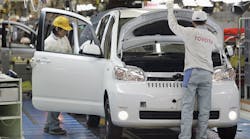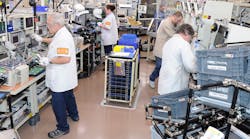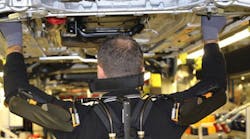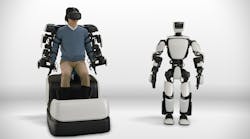Latest from Industry Trends
Toyota to Build $1.6B U.S. Plant, Focus on Self-Driving Tech
Toyota Motor Corp. agreed to buy a stake in Mazda Motor Corp. and jointly build a $1.6 billion plant in the U.S. Asia's largest automaker will also invest more in areas like self-driving cars to stay relevant in an industry upended by technological changes.
As new rivals emerge and cars become autonomous and connected, Toyota will adapt to the change with its new plans. Mergers and acquisitions and using robots to do routine tasks such as making reports and answering queries is one part of it. Toyota will increase the proportion of R&D spending on "crucial fields" including artificial intelligence and environmentally-friendly vehicles to as much as 25% from about 20%.
"I can't say how far it'll expand because honestly, I don't know. But that it's come this far means that I don't imagine it'll stop here," said Senior Managing Officer Nobuhiko Murakami, referring to the company's investments into new technology.
"The reality is that if we don't shift further in that direction, we won't survive the upcoming competition. We have a real sense of crisis about this."
Within minutes of the first-quarter earnings conference ending, Toyota confirmed it will acquire about a 5% stake in Mazda and together they will spend $1.6 billion to build a U.S. auto plant.
Trump's Approval
Automakers are now facing competitors such as Google, Apple Inc., and Amazon.com Inc., Toyota President Akio Toyoda said at a press conference in Tokyo. The new companies are challenging the traditional automakers to improve future mobility, he said. Automakers can't create that future on their own and it's becoming increasingly important for carmakers to seek partners without viewing it from a confrontational perspective, he said.
"In the future, there will be artificial intelligence, autonomous driving, and various environmentally-friendly vehicles that we have to prepare for, and new competitors from emerging markets and IT companies like Apple and Google," Toyoda said. "There are no nautical charts for us to follow."
President Donald Trump cheered Toyota and Mazda's planned factory, the first new U.S. vehicle assembly plant announced since he took office. He called it "a great investment in American manufacturing" in a Friday morning tweet.
Earlier this year, Trump took credit for Toyota investing $1.33 billion in an existing U.S. factory, championing spending by a Japanese automaker he blasted in January for building a plant in Mexico.
Zoom-Zoom
"Toyota may benefit from a taste of Mazda's zoom-zoom flavor and add to its global volume count," said Michelle Krebs, an analyst at car-shopping website Autotrader. "But most of the benefit of the link-up goes to Mazda, which desperately needs U.S. production in this protectionist era and helps with advanced technology development."
Toyota's presence in the U.S. has steadily increased over the decades. From a company that imported all its vehicles from Japan, Toyota has transformed into a company building 70% in North America, its North America Chief Executive Officer Jim Lentz said.
"We have a lot of confidence in the U.S. economy," Lentz said. "We have confidence that we are still going to see a strong auto industry."
Purchasing stakes in other companies is not an everyday phenomenon at Toyota, which in recent years acquired a minority equity stake in Isuzu Motors Ltd. Almost five decades back, Toyota also brought Hino Motors Ltd. and Daihatsu Motor Co. into its fold as partners.
As part of Friday's deal, Toyota will hold about a 5% stake in Mazda, which in turn will take a 0.25% in the maker of Corollas and Camry sedans.
The two companies will consider further strengthening capital tie-up "in line with the progress" of the alliance. The planned U.S. car plant is expected to become operational in 2021 and have a capacity to produce 300,000 units, making Mazda's crossover and Toyota's Corolla.
Raised Forecast
The strategy outlay came as Toyota raised its operating profit forecast for the year ending March to 1.85 trillion yen ($16.8 billion), 16% higher than the company's earlier prediction. First-quarter operating and net income beat analyst estimates.
Even with the improved outlook, the automaker is projecting a second consecutive annual profit decline, which would be a first since 1994. The company will continue to cut costs to avoid the two-year downturn, said Toyota Senior Managing Officer Tetsuya Otake.
Toyota also wants to lead the way in new technologies, such as connected cars and advanced driver-assistance systems, or ADAS. While still touting hydrogen fuel-cell technology as the ultimate answer for zero-emissions vehicles, Toyota is now racing to get battery-electric vehicles ready for the Chinese market and to develop an all-solid-state battery that will extend the driving range and reduce recharging times.
The automaker has yet to realize the full benefits of a revamped manufacturing process, based on using common components that it calls the TNGA for short. The redesigned Camry follows the Prius and C-HR crossover as the third model to be built on the system, which the company has said would shave costs and increase the flexibility of its production, allowing it to be more nimble in adapting to market conditions.
Toyota is undergoing a full-fledged shift to TNGA, which is adding to the forecast in capital expenditure, Otake said.














